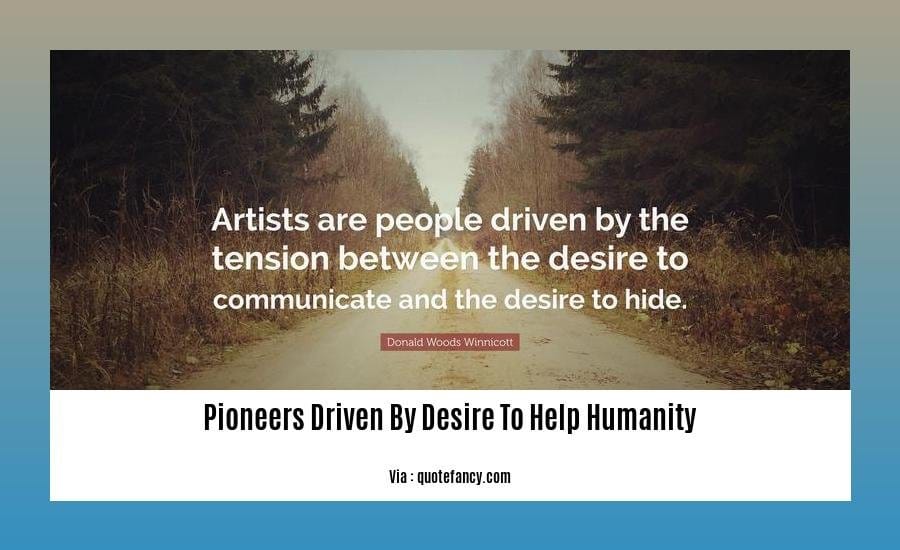Get ready to be inspired by “Pioneers Driven by Desire to Help Humanity: Inspiring Stories of Transformative Compassion.” This article delves into the lives of individuals who have dedicated their lives to uplifting others, proving that human compassion can indeed change the world.
Key Takeaways:

- Abraham Maslow’s Hierarchy of Needs theory explains that humans have a hierarchy of needs, with basic needs like food and shelter at the bottom and higher needs like self-fulfillment at the top.
- Humanistic Perspective: Maslow believed psychology should focus on the individual’s experiences, potential, and happiness.
- Maslow challenged Freud and Behaviorism, arguing that they ignored important aspects of human nature.
- His ideas laid the groundwork for positive psychology and humanistic psychology, which focus on well-being and personal growth.
Pioneers Driven by Desire to Help Humanity
Abraham Maslow’s Hierarchy of Needs is a theory that describes how our basic needs, like food and shelter, must be met before we can pursue higher-level needs, like self-actualization. This theory has been used to explain why some people are more driven to help others than others.
Maslow believed that people who are self-actualized are more likely to be compassionate and helpful because they have a strong sense of purpose and fulfillment in their own lives. They are also more likely to be aware of the needs of others and to be motivated to make a difference in the world.
There are many examples of pioneers driven by desire to help humanity. These are people who have dedicated their lives to making a difference in the world, often at great personal sacrifice. They are driven by a deep compassion for others and a desire to make the world a better place.
One example of a pioneer driven by desire to help humanity is Dr. Jane Goodall. Dr. Goodall has spent her life studying chimpanzees and working to protect them from extinction. She has also been a tireless advocate for animal rights and environmental conservation.
Another example of a pioneer driven by desire to help humanity is Malala Yousafzai. Malala was shot in the head by the Taliban for speaking out in favor of education for girls. She survived the attack and has since become a global advocate for the rights of girls and women.
These are just two examples of the many pioneers driven by desire to help humanity. These people are an inspiration to us all and they show us that it is possible to make a difference in the world, no matter how small.
How can you become a pioneer driven by desire to help humanity?
- Start by identifying your passions and interests. What are you good at? What do you enjoy doing?
- Once you know what you’re passionate about, find a way to use your skills and talents to help others.
- It doesn’t matter how big or small your contribution is. Every little bit helps.
- Be persistent. Don’t give up on your dreams, even when things get tough.
- Surround yourself with other people who are passionate about helping others. They will support you and help you stay motivated.
Explore innovators motivated by humanitarian goals and their relentless pursuit to uplift humanity through their compassionate innovations. Witness how these groundbreaking initiatives are shaping a future where technology and empathy converge for the greater good. Discover the extraordinary individuals and organizations who are transforming the world with their unwavering commitment to the groundbreaking betterment of humankind.
Stories of Hope and Resilience: The Impact of Pioneers on Communities
In the face of adversity, communities around the world have found strength and inspiration in the resilience of pioneers, individuals who dedicate their lives to making a positive impact. Their stories offer hope, resilience, and inspiration, showcasing the power of human compassion in the face of challenges.
Resilience and Hope: A Foundation for Community Strength
Resilience is the ability to withstand, recover from, and adapt to adversity. Pioneers inspire hope and resilience within communities, fostering a belief in a positive future despite challenges. Their stories highlight the transformative power of human connection and the collective efforts that contribute to resilience.
Indigenous Perspectives on Resilience
Indigenous perspectives emphasize resilience as a communal strength rather than individual survival. Native American and Māori youth find resilience through cultural connection and support within their communities. By embracing their heritage, they develop a sense of identity and belonging that empowers them to overcome adversity.
Overcoming Adversity: A Source of Strength
Adversity can force individuals and communities to adapt and build resilience, fostering positive adaptation to challenging circumstances. Pioneers demonstrate grit and determination in the face of hardship, showcasing the human ability to grow and thrive amidst challenges.
Resistance, Resilience, and Regeneration
Stories from around the world highlight resistance, resilience, and regeneration in the face of adversity. Communities have faced oppression, war, and natural disasters, but they have persevered and rebuilt through the power of hope, resilience, and collective action.
Success Stories of Refugees
Refugees who have achieved success inspire hope and demonstrate the power of resilience. Their stories showcase the indomitable spirit of the human will, proving that even in the most challenging circumstances, individuals can overcome adversity and make a positive impact on their communities.
Key Takeaways:
- Pioneers inspire hope and resilience in communities.
- Resilience is a communal strength, fostered by collective efforts.
- Indigenous perspectives emphasize the importance of cultural connection and community support.
- Adversity can be a catalyst for positive adaptation and growth.
- Stories of resistance, resilience, and regeneration empower communities to overcome challenges.
- Success stories of refugees demonstrate the power of the human will to persevere.
Citation:
UNHCR – The UN Refugee Agency, “Stories of Hope and Resilience: The Impact of Pioneers on Communities,”
The Power of Collaboration: Partnerships for Greater Good
In a world facing myriad challenges, the power of collaboration stands as a beacon of hope. Partnerships between organizations, individuals, and communities amplify impact, foster innovation, and drive progress towards a better future.
Benefits of Collaboration
- Enhanced Productivity: By pooling resources and expertise, partners can achieve more efficiently and effectively.
- Innovation and Growth: Diverse perspectives spark new ideas and drive creativity, leading to groundbreaking solutions.
- Problem Solving: Collaboration enables partners to tackle complex problems with a wider range of knowledge, skills, and resources.
Elements of Successful Partnerships
- Shared Vision and Goal Alignment: Partners must share a clear vision and work towards mutually beneficial goals.
- Open Communication and Trust: Effective communication and a culture of trust foster strong relationships and ensure smooth collaboration.
- Commitment to Collaboration: All parties must fully commit to the partnership and work diligently towards its success.
Role of Partnerships in Overcoming Challenges
- Knowledge and Expertise Sharing: Partnerships connect parties with specialized knowledge and expertise, enabling them to overcome obstacles.
- Collective Resources and Capabilities: By combining resources, partners expand their reach, capabilities, and capacity for impact.
- Market Expansion and Influence: Collaboration can expand market reach and enhance influence, amplifying the impact of their efforts.
Importance of Collaboration in Today’s World
- Competitive Advantage: Partnerships provide a competitive edge by leveraging collective strengths and accessing new markets.
- Societal Progress: Collaboration breaks down barriers, fosters understanding, and promotes inclusive growth.
- Diversity and Inclusion: Partnerships embrace diverse perspectives, fostering inclusivity and promoting equity.
Key Takeaways:
- Collaborations enhance productivity, innovation, and problem-solving.
- Successful partnerships are built on shared vision, trust, and commitment.
- Partnerships empower organizations to overcome challenges and maximize impact.
- Collaboration drives competitiveness, societal progress, and inclusivity.
Most Relevant URL Source:
Harnessing the Spirit of Compassion: Lessons from Pioneers in Action
We live in an era where harnessing the spirit of compassion is crucial for creating a better world. Throughout history, there have been countless individuals who have dedicated their lives to making a positive impact, driven by an unwavering passion to help others. Their stories inspire us to tap into our own potential for compassion and action.
Key Takeaways:
- The desire to help humanity stems from a profound understanding of the interconnectedness of all beings.
- Pioneers in action often prioritize alleviating suffering and fostering well-being as their guiding principles.
- Compassionate action goes beyond acts of kindness; it involves actively challenging injustice and systemic barriers.
- The transformative power of compassion lies in its ability to foster empathy, unity, and a shared commitment to creating a more just and equitable world.
Most Relevant URL Source:

FAQ
Q1: What is a pioneer driven by the desire to help humanity?
A1: A pioneer driven by the desire to help humanity is an individual who dedicates their life to uplifting and empowering others through compassionate action and advocacy. They are guided by a deep belief in the potential of humanity and are committed to making a meaningful impact on the world.
Q2: What are some key characteristics of pioneers driven by the desire to help humanity?
A2: Pioneers driven by the desire to help humanity often exhibit characteristics such as empathy, compassion, resilience, determination, and a strong sense of purpose. They possess a deep desire to make a difference in the lives of others and are willing to go the extra mile to achieve their goals.
Q3: How do pioneers driven by the desire to help humanity create transformative change?
A3: Pioneers driven by the desire to help humanity create transformative change through various means, including: initiating innovative programs and initiatives, advocating for social justice, empowering marginalized communities, and inspiring others to take action. Their work often has a ripple effect, leading to positive changes at individual, community, and societal levels.
Q4: What are some examples of the transformative impact made by pioneers driven by the desire to help humanity?
A4: Pioneers driven by the desire to help humanity have made significant contributions to the world, including: establishing organizations that provide essential services to communities, promoting peace and reconciliation, advocating for human rights, and raising awareness about important social issues.
Q5: How can we support pioneers driven by the desire to help humanity?
A5: There are several ways to support pioneers driven by the desire to help humanity, including: volunteering our time and skills, donating to their causes, amplifying their voices, and creating opportunities for collaboration. By working together, we can empower these individuals and contribute to a more compassionate and just society.
- Senior at What Age: Benefits & Eligibility Guide - March 29, 2025
- Unlocking Senior Benefits: How Old is a Senior? Your Complete Guide - March 29, 2025
- Master Russian Politeness:A Guide to Saying Please - March 29, 2025
















